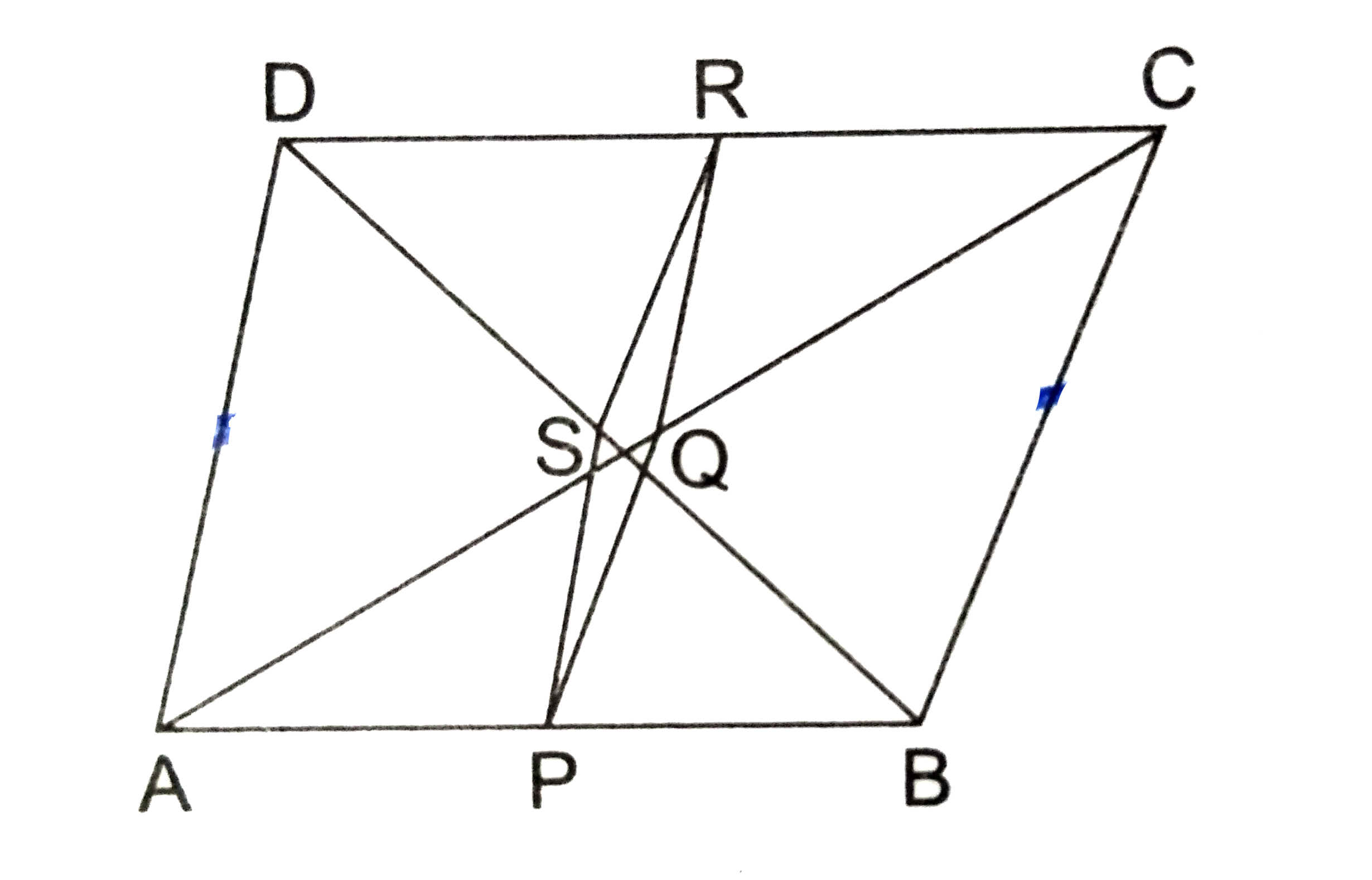ABCD is rectangle formed by the points A(-1, -1), B(-1, 4), C(5, 4) and D(5, -1). If P, Q, R and S be the midpoint of AB, BC, CD and DA respectively, show that PQRS is a rhombus.
To show that the quadrilateral PQRS is a rhombus, we will first find the midpoints P, Q, R, and S of the sides of rectangle ABCD, and then we will calculate the lengths of the diagonals PR and QS to prove that they are equal.
Step 1: Find the midpoints P, Q, R, and S
- Point A: A(-1, -1)
- Point B: B(-1, 4)
- Point C: C(5, 4)
- Point D: D(5, -1)
Midpoint P (AB)
Using the midpoint formula:
P=(x1+x22,y1+y22)
For points A and B:
P=(−1+(−1)2,−1+42)=(−22,32)=(−1,32)
Midpoint Q (BC)
For points B and C:
Q=(−1+52,4+42)=(42,82)=(2,4)
Midpoint R (CD)
For points C and D:
R=(5+52,4+(−1)2)=(102,32)=(5,32)
Midpoint S (DA)
For points D and A:
S=(5+(−1)2,−1+(−1)2)=(42,−22)=(2,−1)
Step 2: Coordinates of the midpoints
Now we have the coordinates of the midpoints:
- P: (−1,32)
- Q: (2,4)
- R: (5,32)
- S: (2,−1)
Step 3: Calculate the lengths of the diagonals PR and QS
Length of diagonal PR
Using the distance formula:
PR=√(x2−x1)2+(y2−y1)2
For points P and R:
PR=√(5−(−1))2+(32−32)2=√(5+1)2+02=√62=6
Length of diagonal QS
For points Q and S:
QS=√(2−2)2+(4−(−1))2=√02+(4+1)2=√52=5
Step 4: Show that PQRS is a rhombus
To show that PQRS is a rhombus, we need to show that the diagonals bisect each other at right angles.
1. Check if diagonals bisect each other:
- Midpoint of PR:
MPR=⎛⎝−1+52,32+322⎞⎠=(42,32)=(2,32)
- Midpoint of QS:
MQS=(2+22,4+(−1)2)=(2,32)
- Since both midpoints are the same, the diagonals bisect each other.
2. Check if diagonals are equal:
- Since PR=6 and QS=5, they are not equal, but we can check the slopes to ensure they are perpendicular.
Step 5: Calculate slopes of diagonals
- Slope of PR:
slopePR=32−325−(−1)=06=0
- Slope of QS:
slopeQS=−1−42−2=undefined
Since one slope is 0 (horizontal) and the other is undefined (vertical), they are perpendicular.
Conclusion
Since the diagonals bisect each other and are perpendicular, quadrilateral PQRS is a rhombus.
- Point A: A(-1, -1)
- Point B: B(-1, 4)
- Point C: C(5, 4)
- Point D: D(5, -1)
Using the midpoint formula:
P=(x1+x22,y1+y22)
For points A and B:
P=(−1+(−1)2,−1+42)=(−22,32)=(−1,32)
For points B and C:
Q=(−1+52,4+42)=(42,82)=(2,4)
For points C and D:
R=(5+52,4+(−1)2)=(102,32)=(5,32)
For points D and A:
S=(5+(−1)2,−1+(−1)2)=(42,−22)=(2,−1)
Now we have the coordinates of the midpoints:
- P: (−1,32)
- Q: (2,4)
- R: (5,32)
- S: (2,−1)
Length of diagonal PR
Using the distance formula:
PR=√(x2−x1)2+(y2−y1)2
For points P and R:
PR=√(5−(−1))2+(32−32)2=√(5+1)2+02=√62=6
For points Q and S:
QS=√(2−2)2+(4−(−1))2=√02+(4+1)2=√52=5
To show that PQRS is a rhombus, we need to show that the diagonals bisect each other at right angles.
- Midpoint of PR:
MPR=⎛⎝−1+52,32+322⎞⎠=(42,32)=(2,32)
- Midpoint of QS:
MQS=(2+22,4+(−1)2)=(2,32)
- Since both midpoints are the same, the diagonals bisect each other.
- Since PR=6 and QS=5, they are not equal, but we can check the slopes to ensure they are perpendicular.
- Slope of PR:
slopePR=32−325−(−1)=06=0
- Slope of QS:
slopeQS=−1−42−2=undefined
Since the diagonals bisect each other and are perpendicular, quadrilateral PQRS is a rhombus.
Topper's Solved these Questions
- COORDINATE GEOMETRYBOOK - RS AGGARWALCHAPTER - COORDINATE GEOMETRYEXERCISE - Exercise 6C
24 Videos
- COORDINATE GEOMETRYBOOK - RS AGGARWALCHAPTER - COORDINATE GEOMETRYEXERCISE - Exercise 6D
17 Videos
- COORDINATE GEOMETRYBOOK - RS AGGARWALCHAPTER - COORDINATE GEOMETRYEXERCISE - Exercise 6A
34 Videos
- CONSTRUCTIONSBOOK - RS AGGARWALCHAPTER - CONSTRUCTIONSEXERCISE - Test Yourself
10 Videos
- HEIGHTS AND DISTANCESBOOK - RS AGGARWALCHAPTER - HEIGHTS AND DISTANCESEXERCISE - Multiple Choice Questions (Mcq)
25 Videos
Similar Questions
ABCD is a rectangle formed by the points A(1, 1),B(1, 4),C(5, 4) and D(5, 1). P, Q, R and S are the midpoints of AB, BC, CD and DA respectively. Is the quadrilateral PQRS a square? A rectangle? or a rhombus? Justify your answer.
View SolutionABCD is a rectangle formed by joining the points A(−1, −1), B(−1, 4), C(5, 4) and D(5, −1). P, Q, R and S are the mid-points of sides AB, BC, CD and DA respectively. Is the quadrilateral PQRS a square? a rectangle? or a rhombus? Justify your answer.
View Solution
Knowledge Check
If ABCD be a rectangle and P, Q, R, S be the mid-points of AB, BC, CD and DA respectively, then the area of the quadrilateral PQRS is equal to
A13 are (ABCD)B34 area (ABCD)C12 area (ABCD)Darea (ABCD)
ABCD is a quadirlateral in which AD= BC. If P,Q,R,S be the midpoints of AB,AC,CD and BD respectively, show that PQRS is a rhombus.

View SolutionABCD is a rectangle and P, Q, R and S are mid-points of the sides AB, BC, CD and DA respectively. Show that the quadrilateral PQRS is a rhombus.
View SolutionABCD is a rhombus and P, Q, R and S are mid-points of the sides AB, BC, CD and DA respectively. Show that the quadrilateral PQRS is a rectangle.
View SolutionLet ABCD be a rectangle. Let P, Q, R, S be the mid-points of sides AB, BC, CD, DA respectively. Then the quadrilateral PQRS is a
View SolutionABCD is a rhombus and P,Q,R,S are the mid-points of AB,BC,CD,DA respectively. Prove that PQRS is a rectangle.
View SolutionABCD is a rhombus and P,Q,R,S are the mid-points of AB,BC,CD,DA respectively. Prove that PQRS is a rectangle.
View Solution19. ABCD is a rectangle having length (x 1) and breadth (x- 1). If P, Q, R and S are the mid-points of sides AB, BC, CD and DA respectively, then the perimeter of quadrilateral PQRS is
View Solution
